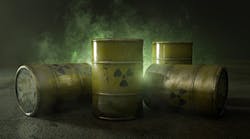The push for nuclear power, especially using small modular reactors (SMRs), is snowballing in Europe as countries rush to find replacements for Russian gas.
The European Commission’s contribution is to label both nuclear and gas as sustainable forms of energy. However, critics have dismissed this decision both as greenwashing, and a threat to the European Union’s aim to become climate neutral by 2050. So, the European Commission has been emphasizing its decision comes with certain provisos. Gas plants would only be considered green if, by 2035, they switched to fuels such as biomass or hydrogen produced with renewable energy. Nuclear power plants would be deemed green only if sites safely manage the disposal of their radioactive waste.
This safe disposal is the focus of new research from the Center for International Security and Cooperation (CISC) at Stanford University, Stanford, Calif.
In a recent article in the Proceedings of the National Academy of Sciences, CISC affiliate Lindsay M. Krall and colleagues make a detailed assessment of SMRs’ impact on the management and disposal of nuclear waste relative to that generated by larger commercial reactors of traditional design. They conclude that existing strategies aren’t designed to cope with the waste from SMR-based nuclear fuel cycles.
The proposed SMRs have purported cost and safety advantages over existing gigawatt-scale light water reactors (LWRs) but few studies have assessed their implications for the back end of the nuclear fuel cycle, note the authors.
They point out often-used simple metrics, such as mass or total radiotoxicity, suggest advanced reactors will generate “less” spent nuclear fuel (SNF) or high-level waste (HLW) than a gigawatt-scale pressurized water reactor (PWR) — the prevalent type of commercial reactor.
As an example, the authors cite research suggesting advanced reactors will reduce the mass and long-lived radioactivity of HLW by 94% and ∼80%, respectively. “These bulk metrics, however, offer little insight into the resources that will be required to store, package, and dispose of HLW,” they stress.
To rectify this, Krall’s team used design and fuel cycle specifications from license and patent applications to compare three SMR designs — ones using water, sodium or molten salt as the primary coolant — to an 1,100-MWelec PWR in terms of the energy-equivalent volume, (radio-)chemistry, decay heat, and fissile isotope composition of (notional) high-, intermediate-, and low-level waste streams.
This research reveals all three designs generate more waste per-unit-of-power-produced than a typical gigawatt-scale PWR. For instance, SNF alone was projected to increase by a factor of up to 5.5. Neutron reflectors or chemically reactive fuels and coolants in SMR designs attribute to the excess waste.
“That said, volume is not the most important evaluation metric; rather, geologic repository performance is driven by the decay heat power and the (radio-)chemistry of SNF, for which SMRs provide no benefit,” explain the authors.
Specifically, they find SMRs will not reduce generation of certain fission products which are important dose contributors for most repository designs. In addition, SMR spent fuel will contain relatively high concentrations of fissile nuclides that will demand novel approaches to evaluating criticality during storage and disposal.
“Since waste stream properties are influenced by neutron leakage, a basic physical process that is enhanced in small reactor cores, SMRs will exacerbate the challenges of nuclear waste management and disposal,” they conclude.
It’s not a conclusion the U.K. nuclear industry, which is leading the European push for SMRs, likely will welcome.
Rolls-Royce, Derby, U.K., hopes its 470-MW SMR technology will become the backbone of a new nuclear energy industry there. According to a recent article in The Guardian, the company already has started building parts for its SMRs in anticipation of regulatory approval by 2024 and grid connection in 2029.
Nuclear Waste Services (NWS), Didcot, Oxford, U.K., the U.K. government’s integrated nuclear waste management organization, currently is pursuing a long-term strategy to encourage communities to consider building geological disposal facilities (GDFs) in their local areas. So keen is NWS to find hosts that up to £1 million/yr (≈$1.22 million/yr) in funding is available to local communities who engage in discussions about hosting a GDF.



